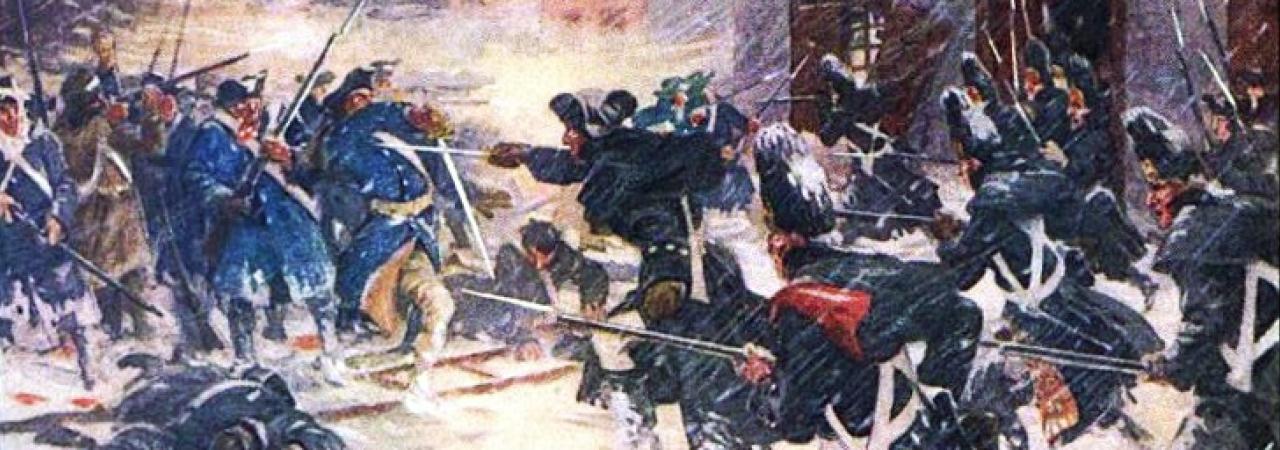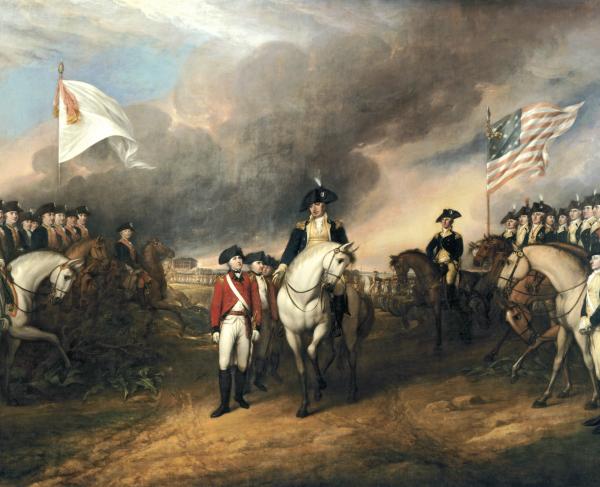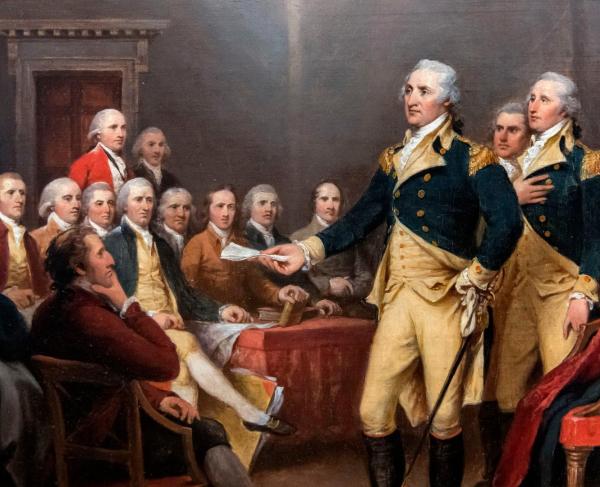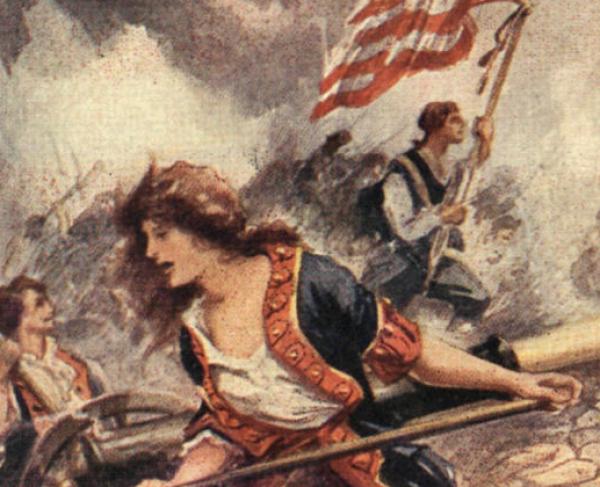
Weather played an incredibly important role in 18th-century warfare. In an age before industrialization, the weather played a decisive role in how armies moved and when and how battles were fought.
Because of the weather, military commanders would usually plan campaigns for warmer months, and in the colder months, they would go into winter quarters. Maneuvering thousands of men, horses, and artillery through muddy roads or bad weather made the idea of pausing a campaign for better weather very appealing. In winter quarters, troops would prepare for the military campaign season.
Besides the logistics of moving an 18th-century army in bad weather, another major factor that often required armies to fight in better weather was the weaponry of the time. In the 18th century, the main weapon in the armies was smoothbore flintlock muskets. These muskets required pouring a little bit of black powder from a paper-wrapped cartridge into an open pan on the musket lock, and then pouring the remaining black powder and musket ball down the barrel and ramming it into place. When the trigger was pulled, the hammer, with a piece of flint attached to it, would fall forward. The flint would strike a piece of steel and open the pan on the lock, sending sparks down onto the black powder and firing the musket. If the weather was rainy and the black powder got wet at any point in this process, these weapons would become unusable. Soldiers could attach a steel bayonet to their muskets, thus converting their muskets to spears. Ideally, commanders would attempt to fight on clear days to avoid misfires of their muskets. The muskets and cannons also produced a large amount of white smoke that would engulf the entire battlefield also making good weather and daylight important in successfully fighting an 18th-century battle.
Weather played an important role in all aspects of 18th-century life since North America was experiencing a “little Ice Age” during this time with colder than average winters. The worst winter in America was likely the “hard winter” of 1779-1780 during the Revolutionary War. Over the course of that winter, in Morristown, New Jersey (where George Washington’s Continental Army was encamped) there were twenty-six snowstorms, six of which were blizzards. Every saltwater inlet from North Carolina to Canada froze over completely. New York harbor froze over with ice so thick that British soldiers stationed there were able to march from Manhattan to Staten Island. The weather was so cold that winter that some British sentries froze to death at their posts.
Perhaps no conflict has exhibited how important the weather was than the Revolutionary War. On numerous occasions, the weather would affect the outcome of battles and campaigns of the war.
The first winter of the war (1775-1776) saw some major undertakings impacted by weather. In the fall of 1775, American Colonel Benedict Arnold led an expedition through the wilderness of modern-day Maine to attack the British fortress city of Quebec. The expedition pushed through despite terrible rain and snowstorms and a lack of supplies. Little more than half of the 1,100 men who were in the expedition made it to Quebec. Starving and exhausted, the small group of men met up with General Richard Montgomery, and the small army laid siege to the city of Quebec. As many of the men’s enlistments expired at the end of the year, Montgomery decided to assault the city. They attacked on December 31, 1775, in the middle of a blizzard. While winter operations usually were postponed because of this type of weather, in Quebec and at other times in the war, because of enlistments or other logistical issues, combat would occur in the winter, and in this case a blizzard. The battle was a disaster for the Americans. Montgomery was killed and the Americans lifted the siege.
That same winter, Colonel Henry Knox had the daunting task of moving more than 50 pieces of artillery overland through the Berkshires from Fort Ticonderoga to Washington’s Army at Cambridge, Massachusetts. This “Noble Train of Artillery” had to cross frozen rivers and pass through the mountains. They built sleds to help transport the artillery. The weather slowed their progress, but by the end of January 1776, the artillery made it to the Continental Army. This artillery would prove decisive in fortifying Dorchester Heights and driving the British Army from Boston. General William Howe in early March would plan to attack the American position at Dorchester, but a storm struck that partially caused him to call off the attack and a few days later, the British evacuated Boston.
The main theatre of the war then moved to New York City, which the British attacked in August of 1776. In New York, George Washington divided his army between Manhattan Island and Long Island. The British attacked the portion of the army on Long Island on August 27, 1776, and drove the Americans back to the area of Brooklyn Heights, with the East River to their backs. As the British laid siege to the Americans at Brooklyn, Washington made the daring decision to evacuate his 9,000 men out of Brooklyn across the East River onto Manhattan. With the Royal Navy commanding the harbor and the British infantry just to their front, the evacuation would be incredibly risky. However, the Americans were aided by the weather. On August 28, the winds shifted, and a nor’easter arrived that prevented the Royal Navy from entering the East River and cutting Washington’s men off. Then, on the night of August 29, Washington began moving all 9,000 men across the river to Manhattan. The nor’easter wind died down that night and made it easier for the troops to get in small boats at Brooklyn ferry and cross the river. As the sun began to rise on August 30, a heavy fog descended on Brooklyn, concealing Washington’s troops. The fog hung around for just enough time that the rear guard was able to get in boats leave Brooklyn. As the final boats departed Brooklyn, the fog lifted and within a matter of minutes, British troops advanced into the now deserted American lines. Without the weather, it is likely the Americans would not have been successful in their evacuation.
Weather played a fortuitous role in one of the most important military campaigns of the war, the Trenton-Princeton campaign. After suffering losses across the state of New Jersey in November of 1776, Washington and his despondent army crossed the Delaware River into Pennsylvania. General Howe put his army into winter quarters in New York City but left behind, in small villages across New Jersey, small garrisons of British and German troops. With his army’s enlistments about to expire, Washington made the decision to attack a brigade of Hessians stationed at Trenton, New Jersey. He planned to cross the Delaware River on Christmas evening and attack the garrison before daylight on December 26, 1776. As the Americans began crossing the river, another nor’easter arrived. One soldier remembered that “it rained, hailed, snowed, and froze, and at the same time blew a perfect hurricane.” The snowstorm made the crossing of the river difficult, but it also drove in the Hessian pickets, allowing Washington to maintain the element of surprise. The Americans fought the Battle of Trenton in the blowing snowstorm and won a much-needed victory. When the British learned of the defeat, they immediately sent thousands of troops down to Trenton to attack Washington. As the British began the approach to Trenton on January 2, 1777, the weather warmed enough to make the road a muddy quagmire that slowed the British advance. Slogging through the muddy roads and fighting American troops on the road slowed the British long enough to prevent a major engagement that day. That night, the weather turned extremely cold, freezing the roads. With the roads frozen over, Washington made the bold decision to march around the British flank and attack their rearguard at Princeton. With the victory at Princeton, Washington had saved the American cause and turned the tables of the war, a feat that was aided greatly by the weather.
However, at other times, the weather aided the British. At the Battle of Germantown in October of 1777, Washington launched an early morning attack on the British Army. While the battle began well for the Americans, a heavy fog (along with smoke from the battle) made it difficult to discern friend from foe. The results were some friendly fire incidents in which Americans fired into other Americans by accident. This helped to stymie the American assault and the British counterattacked and drove the Americans from the field.
While the climate was generally cooler during the war, the Revolution also saw one of the hottest battles as well. On June 28, 1778, the British and Americans fought the Battle of Monmouth on one of the hottest days of the year, with highs of temperatures near 100 degrees Fahrenheit. With the battle raging all day, more men died from heat exhaustion than enemy musket balls or cannon shots.
Whether it was snowstorms, fog, rain, or unbearable heat, weather, entirely out of the control of any army, played an enormous role in 18th-century warfare. Thus, the fates of people, nations, and empires often changed as the result of the weather.
Related Battles
515
19
1,111
533
325
381


